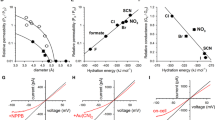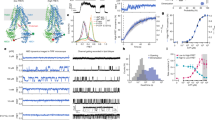Abstract
The nucleotide binding domains (NBDs) within CFTR were initially predicted to lie in the cell cytoplasm, and to gate anion permeability through a pore that was present in membrane spanning α helices of the overall polypeptide. Our studies designed to characterize CFTR suggest several important features of the isolated nucleotide binding domain. NBD-1 appears to bind nucleotides with similar affinity to the full-length CFTR protein. In solution, the domain contains a high β sheet content and self-associates into ordered polymers with molecular mass greater than 300,000 Daltons. The domain is very lipophilic, disrupts liposomes, and readily enters the planar lipid bilayer. Clinically important mutations in the domain may disrupt the nucleotide binding capabilities of the protein, either through a direct effect on the nucleotide binding site, or through effects that influence the overall folding of the domain in vitro. Finally, after expression in human epithelial cells (including epithelial cells from a CF patient), the first nucleotide binding domain targets the plasma membrane even in the absence of other constituents of full-length CFTR and mediates anion permeability in these cells.
Similar content being viewed by others
REFERENCES
J. R. Riordan, J. M. Rommens, B. T. Kerem, N. Alon, R. Rozmahel, Z. Grzelczak, J. Zielenski, S. Lok, N. Plavsic, J. L. Chou, M. L. Drumm, M. C. Iannuzzi, F. S. Collins, and L. C. Tsui, “Identification of the cystic fibrosis gene: Cloning and characterization of complementary DNA,” Science 245, 1066–1073 (1989).
S. C. Hyde, P. Emsley, M. J. Martshorn, M. M. Mimmack, U. Gileadi, S. R. Pearce, M. P. Gallagher, D. R. Gill, R. E. Hubbard, and C. F. Higgins, “Structural model of ATP-binding proteins associated with cystic fibrosis, multidrug resistance, and bacterial transport,” Science 346, 362–365 (1990).
C. S. Mimura, S. R. Holdbrook, and G. F. I. Ames. “Structural model of the nucleotide binding conserved component of periplasmic permeases,” Proc. Natl. Acad. Sci. USA 88, 84–88 (1991).
J. Hartman, Z. Huang, T. A. Rado, S. Peng, T. Jilling, D. D. Muccio, and E. J. Sorscher, “Recombinant synthesis, purification and nucleotide binding characteristics of the first nucleotide binding domain of the cystic fibrosis gene product,” J. Biol. Chem. 267, 6455–6458 (1992).
N. Arispe, E. Rojas, J. Hartman, E. J. Sorscher, and H. Pollard. “Intrinsic anion channel activity of the recombinant first nucleotide binding fold domain of the cystic fibrosis transmembrane regulator protein,” Proc. Natl. Acad. Sci. USA 89, 1539–1543 (1992).
J. Logan, D. Hiestand, P. Daram, Z. Huang, D. D. Muccio, B. Haley, W. Cook, and E. J. Sorscher, “CFTR mutations which disrupt nucleotide binding,” J. Clin. Invest. 94, 228–236 (1994).
B. E. Cohen, G. Lee, K. A. Jacobson, Y.-C. Kim, Z. Huang, E. J. Sorscher, and H. B. Pollard, “CPX (1,3-dipropyl-8-cyclo-pentylxanthine) and other alkylxanthines differentially bind to the wild type and ΔF508 mutant first nucleotide-binding fold (NBF-1) domains of the cystic fibrosis transmembrane conductance regulator,” Biochemistry 36, 6455–6461 (1997).
S. Peng, M. Sommerfelt, J. Logan, Z. Huang, T. Jilling, K. Kirk, E. Hunter, and E. J. Sorscher, “One-step affinity isolation of recombinant protein using the baculovirus/insect cell expression system,” Protein Express. Purif. 4, 95–100 (1993).
S. Peng, M. A. Sommerfelt, G. Berta, A. K. Berry, K. Kirk, E. Hunter, and E. J. Sorscher, “Rapid purification of recombinant baculovirus using fluorescence-activated cell sorting,” Biotechniques 14, 274–277 (1993).
J. Hartman, R. A. Frizzell, T. A. Rado, D. J. Benos, and E. J. Sorscher, “Affinity purification of insoluble recombinant fusion proteins containing glutathione-S-transferase,” Biotechnol. Bioeng. 39, 828–832 (1992).
J. P. Clancy, J. S. Hong, Z. Bebok, S. A. King, S. Demolombe, M. D. DuVall, D. M. Bedwell, and E. J. Sorscher, “Expression of R553X, G542X, and CFTR nucleotide-binding domain-1 causes increased anion permeability in epithelial cells,” submitted.
S. A. King, J. P. Clancy, P. E. Prevelige, Jr., Z. Huang, J. S. Hong, M. J. Jablonski, J. J. Lebowitz, and E. J. Sorscher, “ΔF508 decreases the self-association of the first nucleotide-binding domain of CFTR,” Ped. Pulm. Suppl. 13, 37 (1996).
E. A. Pasyk, and J. K. Foskett, “Mutant (ΔF508) cystic fibrosis transmembrane conductance regulator Cl− channel is functional when retained in endoplasmic reticulum of mammalian cells,” J. Biol. Chem. 270, 12347–12350 (1995).
C. E. Bear, C. Li, N. Kartner, R. J. Bridges, T. J. Jensen, M. Ramjeesingh, and J. R. Riordan, “Purification and functional reconstitution of the cystic fibrosis transmembrane conductance regulator (CFTR),” Cell 68, 809–818 (1992).
Z. Bebok, C. J. Venglarik, Z. Panczel, T. Jilling, K. L. Kirk, and E. J. Sorscher, “Epithelial polarity and trans-epithelial transport through ΔF508 CFTR,” submitted.
B. H. Qu, and P. J. Thomas, “Alteration of the cystic fibrosis transmembrane conductance regulator folding pathway,” J. Biol. Chem. 271, 7261–7264 (1996).
P. J. Thomas, Y. H. Ko, and P. L. Pedersen, “Altered protein folding may be the molecular basis of most cases of cystic fibrosis,” FEBS Lett. 312, 7–9 (1992).
J. Logan, D. Hiestand, J. Hartman, Z. Huang, D. D. Muccio, B. Haley, W. J. Cook, and E. J. Sorscher, “CFTR mutations which disrupt nucleotide binding,” Ped. Pulm. Suppl. 9, 204 (1993).
S. Bar-Noy, P. McPhie, G. Lee, Z. Huang, E. J. Sorscher, O. Eidelman, and H. B. Pollard, “ΔF508 mutation in CFTR modifies phospholipid interactions with NBF-1 domain: Implications for the pathogenesis of cystic fibrosis,” Ped. Pulmon. Suppl. 13, 17a (1996).
G. Lee, B. E. Cohen, S. Bar-Noy, O. Eidelman, K. A. Jacobson, and H. B. Pollard, “CPX binds to 30-residue peptide domain lα (CFTR [477-508]) from first nucleotide binding fold, and potentiates peptide-membrane interactions,” Ped. Pulmon. Suppl. 12, 23a (1995).
V. Baichwal, D. Liu, and G. F. L. Ames, “The ATP-binding component of prokaryotic traffic ATPase is exposed to the periplasmic (external) surface,” Proc. Natl. Acad. Sci. USA 90, 620–624 (1993).
E. Schneider, S. Hunke, and S. Tebbe, “The MalK protein of the ATP-binding cassette transporter for maltose of Escherichia coli is accessible to protease digestion from the periplasmic side of the membrane,” J. Bacteriol. 177(18), 5364–5367 (1995).
R. Dudler, C. Schmidhauser, R. W. Parish, R. E. H. Wettenhall, and T. Schmidt, “A mycoplasma high-affinity transport system and the in vivo invasiveness of mouse sarcoma cells,” EMBO J. 7, 3963–3970 (1988).
I. D. Hiles, M. P. Gallagher, D. J. Jamieson, and C. F. Higgins. “Molecular characterization of the oligopeptide permease of Salmonella typhimurium,” J. Mol. Biol. 195, 125–142 (1987).
C. A. Doige and G. F. Ames, “ATP-dependent transport systems in bacteria and humans: Relevance to cystic fibrosis and multidrug resistance,” Annu. Rev. Microbiol. 47, 291–319 (1993).
Y. H. Ko, M. R. Delannoy, and P. L. Pedersen, “Cytosolic localization of NBF1 of CFTR rather than an association with the lipid bilayer,” Ped. Pulm. Suppl. 12, 16 (1995).
D. B. Gruis, K. E. Franke, and E. M. Price, “Extracellular labeling of recombinant NBD-1,” Ped. Pulmon. Suppl. 12, 6a (1995).
M. P. Anderson, R. J. Gregory, S. Thompson, D. W. Souza, S. Paul, R. C. Mulligan, A. E. Smith, and M. J. Welsh, “Demonstration that CFTR is a chloride channel by alteration of its anion selectivity,” Science 253, 202–205 (1991).
T. P. Carrol, M. M. Morales, S. B. Fulmer, S. S. Allen, T. R. Flotte, G. R. Cutting, and W. B. Guggino, “Alternate translation initiation codons can create functional forms of cystic fibrosis transmembrane conductance regulator,” J. Biol. Chem. 270, 11941–11946 (1995).
D. N. Sheppard, L. S. Ostedgaard, D. P. Rich, and M. J. Welsh, “The amino-terminal portion of CFTR forms a regulated Cl− channel,” Cell 76, 1091–1098 (1994).
M. Cheung and M. H. Akabas, “Identification of cystic fibrosis transmembrane conductance regulatory channel-lining residues in and flanking the M6 membrane-spanning segment,” Biophys. J. 70, 2688–2695 (1996).
J. Marshall, J. S. Fang, L. S. Ostedgaard, C. R. O'Riordan, D. Ferrara, J. F. Amara, H. Hoppe IV, R. K. Scheule, M. J. Welsh, A. E. Smith, and S. H. Cheng, “Stoichiometry of recombinant cystic fibrosis transmembrane conductance regulator in epithelial cells and its functional reconstitution into cells in vitro,” J. Biol. Chem. 269, 2987–2995 (1994).
S. Sato, C. L. Ward, M. E. Krouse, J. J. Wine, and R. R. Kopito, “Glycerol reverses the misfolding phenotype of the most common cystic fibrosis mutation,” J. Biol. Chem. 271, 635–638 (1996).
C. R. Brown, L. Q. Hong-Brown, J. Biwersi, A. S. Verkman, and W. J. Welch, “Chemical chaperones correct the mutant phenotype of the ΔF508 cystic fibrosis transmembrane conductance regulator protein,” Cell Stress Chaperones 1, 117–125 (1996).
P. J. Thomas, as presented at the Williamsburg CF Meetings, Williamsburg, Virginia, 1995.
B. Moss, O. Elroy-Stein, T. Mizukami, W. A. Alexander, and T. R. Fuerst, “New mammalian expression vectors,” Nature 348, 91–92 (1990).
Author information
Authors and Affiliations
Rights and permissions
About this article
Cite this article
Clancy, J.P., Bebök, Z. & Sorscher, E.J. Purification, Characterization, and Expression of CFTR Nucleotide-Binding Domains. J Bioenerg Biomembr 29, 475–482 (1997). https://doi.org/10.1023/A:1022487024031
Issue Date:
DOI: https://doi.org/10.1023/A:1022487024031




